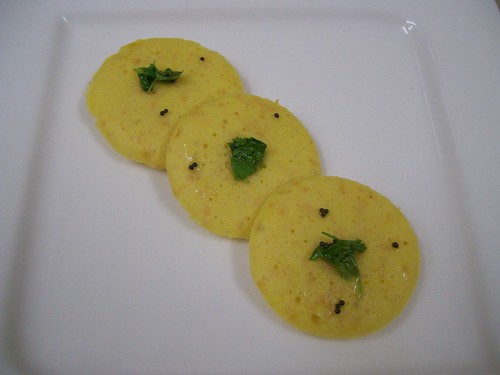What's an easy recipe? I've found that the answer lies not in how complicated a process is, but in how familiar we are to the dish. Growing up with a cuisine helps. For don't I dish out punjabi chhole and rajma masala with elan, but shudder at making appams. Because Indian cuisine is so varied, there are enough challenges for everyone to pick from. Just what Srivalli's brainchild, the newly minted Indian Cooking Challenge wants to do.
We have a long list of dishes that would be familiar and homely to some but unknown challenges to the others. The first one, dhokla, should tell you that. I've eaten plenty of this Gujarati staple as a snack but my couple of attempts to make it at home were total failure. Enter Srivalli's recipe, which I followed verbatim - the only change was my steaming the batter in idli moulds, the only steamer in my kitchen.
I am sure there would be tons of versions of this recipe floating around today, but here's a condensed version. I divided Srivalli's recipe by a third so step one was mixing 1/2 cup gramflour/besan with 1/6 cup curd, 1/6 cup water and a pinch of baking soda. I kept it aside for one hour. Around the end of this rising time, I set some water to heat in my idli steamer and sprinkled a light dust of eno on the idli moulds.
To the batter, I added a mixture of a tsp of oil, a pinch of turmeric, salt, 1/4 tsp red chilli powder and juice of half a lemon. I then added 1/3rd of an eno packet, mixed lightly and poured the batter into idli moulds. Steamed them for 7 minutes, then turned off the gas and let the dhoklas rest for another 5 minutes.
Just before eating, I heated some oil in a pan and added coriander leaves and mustard seeds. When the mustard started popping, I poured the tempering over the dhoklas.
The result was perfect, fluffy dhoklas. And because I omitted the last step in the recipe, they come minus the water every store pours on finished dhoklas intending to make them soft , but actually making them soggy.
I didn't make the green chutney, but Srivalli assures me that was optional. What I ate them with instead was my bottled tamarind chutney. Overall, a perfect snack!
We have a long list of dishes that would be familiar and homely to some but unknown challenges to the others. The first one, dhokla, should tell you that. I've eaten plenty of this Gujarati staple as a snack but my couple of attempts to make it at home were total failure. Enter Srivalli's recipe, which I followed verbatim - the only change was my steaming the batter in idli moulds, the only steamer in my kitchen.
I am sure there would be tons of versions of this recipe floating around today, but here's a condensed version. I divided Srivalli's recipe by a third so step one was mixing 1/2 cup gramflour/besan with 1/6 cup curd, 1/6 cup water and a pinch of baking soda. I kept it aside for one hour. Around the end of this rising time, I set some water to heat in my idli steamer and sprinkled a light dust of eno on the idli moulds.
To the batter, I added a mixture of a tsp of oil, a pinch of turmeric, salt, 1/4 tsp red chilli powder and juice of half a lemon. I then added 1/3rd of an eno packet, mixed lightly and poured the batter into idli moulds. Steamed them for 7 minutes, then turned off the gas and let the dhoklas rest for another 5 minutes.
Just before eating, I heated some oil in a pan and added coriander leaves and mustard seeds. When the mustard started popping, I poured the tempering over the dhoklas.
The result was perfect, fluffy dhoklas. And because I omitted the last step in the recipe, they come minus the water every store pours on finished dhoklas intending to make them soft , but actually making them soggy.
I didn't make the green chutney, but Srivalli assures me that was optional. What I ate them with instead was my bottled tamarind chutney. Overall, a perfect snack!


Comments
u r accepting all challenges..huh??
Thanks for making dhokla different from others..got bored of seeing diamonds n squares..they look yummy..